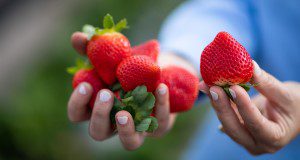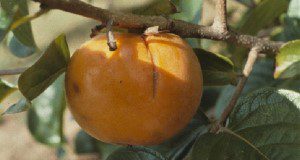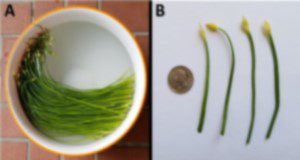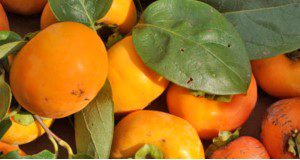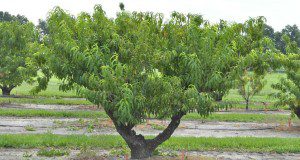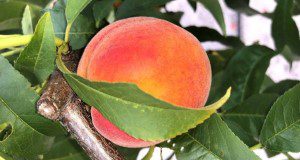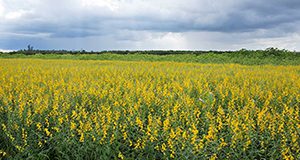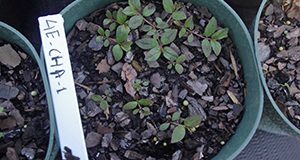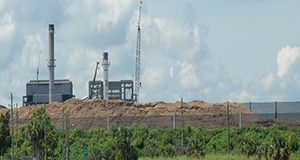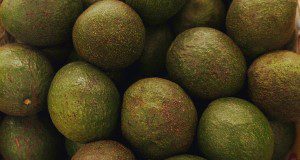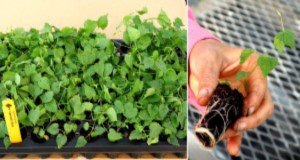Pears are a great tree to grow for an edible landscape or fruit garden. However, pears are not adapted to all areas in Florida, and only a few cultivated varieties will grow well here. An adaptation to warm winters (low chill hours) and disease resistance are the main factors for success. This new 6-page publication of the UF/IFAS Horticultural Sciences Department provides information to help homeowners select and grow pears successfully in Florida. Written by Juanita Popenoe, Ali Sarkhosh, and Dustin Huff.
https://edis.ifas.ufl.edu/hs1393
Category: Crops
Planning for a Successful Commercial Subtropical/Tropical Fruit Grove
Planning is the key to successful grove establishment, maintenance, and production. Developing a detailed infrastructure description and plan, cultural program, and financial and marketing plan for a new or existing grove with a new fruit crop will save you time and money and help minimize mistakes. Prospective growers should compile and analyze information needed to select a grove site, establish the needed infrastructure, and develop maintenance plans for the plants and how the production will be marketed. This new 15-page publication of the UF/IFAS Horticultural Sciences Department presents an outline of the type of information growers need when establishing a tropical fruit grove or contemplating management or modification of an existing grove. Written by Jonathan Crane, Yuncong Li, Edward Evans, Fredy Ballen, and Jeff Wasielewski.
https://edis.ifas.ufl.edu/hs1387
Métodos para el establecimiento de trasplantes de fresa en Florida
Florida es el segundo productor de fresa más grade de los Estados Unidos, con un valor estimado de $337 millones. La siembra inicia entre finales de septiembre y mediados de octubre, en momentos donde las altas temperaturas representan un reto significativo para la sobrevivencia de los trasplantes, y por tanto también para el rendimiento y la calidad. El propósito principal de esta publicación es proporcionar recomendaciones basadas en resultados de investigación sobre métodos de establecimientos de trasplantes para productores de fresas en la Florida.
This new 5-page publication of the UF/IFAS Horticultural Sciences Department is the Spanish translation of HS1376, Methods for Strawberry Transplant Establishment in Florida. Written by Emmanuel Torres-Quezada, Lincoln Zotarelli, Vance M. Whitaker, and Shinsuke Agehara.
https://edis.ifas.ufl.edu/hs1378
Methods for Strawberry Transplant Establishment in Florida
Florida is the second largest strawberry producer in the United States, with an annual farm gate value of about $300 million. Planting occurs from late September through late October, and high air temperatures pose significant challenges for transplant establishment and thus yield and fruit quality. The primary purpose of this new 4-page publication of the UF/IFAS Horticultural Sciences Department is to provide research-based recommendations on transplant establishment methods for strawberry growers in Florida. The techniques presented are overhead irrigation application methods and practices, strawberry plugs and bare-root transplants, crop protectants, and reflective mulching. Written by Emmanuel Torres-Quezada, Lincoln Zotarelli, Vance M. Whitaker, and Shinsuke Agehara.
https://edis.ifas.ufl.edu/hs1376
Tomato Production in Florida Using Fertigation Technology
Tomato is in high demand because of its taste and health benefits. In Florida, tomato is the number one vegetable crop in terms of both acreage and value. Because of its high value and wide acreage, it is important for tomato production to be efficient in its water and nutrient use, which may be improved through fertigation practices. Therefore, the objective of this new 7-page article is to disseminate research-based methods of tomato production utilizing fertigation to enhance yield and nutrient use efficiency. Written by Mary Dixon and Guodong Liu, and published by the UF/IFAS Horticultural Sciences Department.
https://edis.ifas.ufl.edu/hs1392
Goji Berry: a Novel Nutraceutical “Superfruit” for Florida Master Gardeners
Goji berries have been used in both fresh and processed forms for food and medicine for more than 4,000 years in China. The goji berry fruit is known as a “superfruit” thanks to its high levels of vitamins and minerals, as well as other medicinal benefits recognized in many countries around the world. Most of Florida’s climate is favorable for goji berry, and a few Florida growers have cultivated it for years. This species can tolerate infertile and unfavorable growth conditions, and the prominent health benefits of this crop may be highly profitable for Florida growers. The objective of this new 7-page article is to provide a general overview of how the goji berry can be grown in Florida. Written by Yujie Jiao and Guodong Liu, and published by the UF/IFAS Horticultural Sciences Department.
https://edis.ifas.ufl.edu/hs1391
Elderberry and Elderflower (Sambucus spp.): A Cultivation Guide for Florida
The purpose of this new 9-page paper, written by David Jarnagin, Ali Sarkhosh, Juanita Popenoe, Steve Sargent, and Kevin Athearn, and published by the UF/IFAS Horticultural Sciences Department, is to provide information on growing American elderberry in Florida as an alternative crop for commercial growers as well as homeowners. Although elderberry has been historically grown at commercial scale in some world regions, especially throughout Europe, in the New World it has not found meaningful commercial acceptance until recently.
https://edis.ifas.ufl.edu/hs1390
Japanese Persimmon Cultural Practices in Florida
Persimmons are considered a relatively sustainable crop in Florida, rated as a 6 out of 10 on an assessment of agricultural sustainability, with a moderate commercial potential and high direct-to-consumer potential. Trees grow and fruit best in central and northern Florida and can produce high yields of good-quality fruit. This new 13-page publication of the UF/IFAS Horticultural Sciences Department describes how to propagate and establish persimmons in Florida, while also providing information on irrigation, fertilization, harvest, pests, diseases, and more. Written by Ali Sarkhosh, Dustin M. Huff, and Peter C. Andersen.
https://edis.ifas.ufl.edu/hs1389
Leek Cultivation Guide for Florida
Leek (Allium porrum L.) is a member of Amaryllidaceae, a family with ornamental crops, like amaryllis, and with vegetable crops, like onion. Leek is a highly demanded vegetable because of its flavor and nutrient content. Although there is great potential for leek to be grown commercially in Florida due to demand and appropriate climatic conditions, the United States does not currently produce a significant quantity of leek compared to countries such as Indonesia, Turkey, and China. This new 7-page publication of the UF/IFAS Horticultural Sciences Department, written by Mary Dixon and Guodong Liu, provides a basic guide to cultivation of leek in Florida, as well as information on its agricultural, culinary, and medicinal uses.
https://edis.ifas.ufl.edu/hs1388
Cultivares de Caqui Japonés en Florida
El caqui japonés, Diospyros kaki L., es originario de China y fue cultivado por primera vez en Florida en el año 1870. El número de fincas productoras de caqui en Florida ha aumentado de 164 a 227 durante el período 2012-2017, haciendo mayor hincapié en la naturaleza de pequeña escala de la superficie promedio de fincas en esta industria. Los árboles crecen y fructifican mejor en el centro y norte de Florida, y pueden producir altos rendimientos de fruta de buena calidad. En el sur de Florida, la calidad de los frutos de tipo astringentes es mejor que la de los de tipo no astringentes.
This new 12-page article is the Spanish translation of SP101/MG242, Japanese Persimmon Cultivars in Florida. Written by Ali Sarkhosh, Peter C. Andersen, and Dustin Huff; translated by Jonathan Clavijo Herrera; and published by the UF/IFAS Horticultural Sciences Department.
https://edis.ifas.ufl.edu/mg460
Summer Pruning in Low-Chill Peaches Grown in Florida
Low-chill peach trees growing under Florida conditions can become vigorous and large. Summer pruning is a management strategy that can be applied to help restructure the canopy, direct the tree’s resources into fruit production, and improve the efficiency of fieldwork. Without summer pruning, peach orchards in subtropical regions will continue to grow vigorously and, if left unmanaged, will reach a point at which ladders will be required to harvest and maintain the trees. Summer pruning can be a means of reducing overall tree size, redistributing fruiting wood for easier harvesting, reducing disease pressure, and increasing fruit quality. This new 5-page publication of the UF/IFAS Horticultural Sciences Department, written by Ali Sarkhosh, Dustin Huff, Trequan McGee, and Juanita Popenoe, provides an illustrated step-by-step guide to summer pruning of peach trees.
https://edis.ifas.ufl.edu/hs1377
Oportunidades alternativas para fincas pequeñas: Producción de durazno y nectarinas versión revisada
El suave clima invernal de Florida y el comienzo de la temprano de primavera ofrecen oportunidades únicas para la producción de duraznos y nectarinas de temporada temprana. Durante los últimos 12 años, la Universidad de Florida ha lanzado muchos cultivares nuevos de durazno y nectarina. Estos nuevos y mejorados cultivares han aumentado el potencial de expansión del aspecto comercial de melocotones y nectarinas en gran parte de la península de Florida y en las regiones de la Costa del Golfo del sureste de los Estados Unidos.
This new 5-page article is the Spanish translation of RFAC018, Alternative Opportunities for Small Farms: Peach and Nectarine Production Review. Written by Ali Sarkhosh, Mercy Olmstead, Jeff Williamson, Jose Chaparro, and Juanita Popenoe, translated by Eva Pabon, and published by the UF/IFAS Horticultural Sciences Department.
https://edis.ifas.ufl.edu/hs1374
Questions and Answers for Using Sunn Hemp (Crotalaria juncea L.) as a Green Manure Cover Crop
This 4-page document synthesizes information about the warm-season cover crop, sunn hemp. It addresses frequently asked questions for growers and summarizes the expanding body of sunn hemp research. The information is provided so growers in Florida can learn about up-to-date cultivation and management options as well as better understand sunn hemp’s practical uses. Written by Thioro Fall, Ariel Freidenreich, Stacy Swartz, Christopher Vincent, Yuncong Li, and Zachary Brym, and published by the UF/IFAS Agronomy Department, July 2020.
https://edis.ifas.ufl.edu/ag443
Biology and Management of Garden Spurge (Euphorbia hirta) in Ornamental Crop Production
Garden spurge is a prostrate, herbaceous, short-lived, warm-season annual weed commonly found in Florida landscapes, container nurseries, and other agricultural production areas. This 5-page article is written to aid green industry professionals and others in the identification and management of garden spurge in and around ornamental plants. Written by Thomas Smith, Chris Marble, Shawn Steed, and Nathan Boyd, and published by the UF/IFAS Environmental Horticulture Department, July 2020.
https://edis.ifas.ufl.edu/ep586
Bagasse: A Potential Organic Soil Amendment Used in Sugarcane Production
Bagasse is an agricultural by-product derived from the sugarcane milling process. It is a dry and fibrous residue left after the extraction of sugar juice from sugarcane. This 5-page document is a preliminary investigation into the possible effects of using bagasse as a soil amendment. Written by Jehangir H. Bhadha, Nan Xu, Raju Khatiwada, Stewart Swanson, and Chris LaBorde, and published by the UF/IFAS Department of Soil and Water Sciences, August 2020.
https://edis.ifas.ufl.edu/ss690
Production Guide for Choy Sum: An Emerging Asian Vegetable in Florida
Choy sum, also known as Chinese flowering cabbage, is a leafy vegetable that has been widely cultivated in southern China for more than 1,000 years, and is currently cultivated and consumed by a growing population in the western world. This new 5-page publication of the UF/IFAS Horticultural Sciences Department, written by Yanlin Wang and Guodong Liu, provides a brief overview of choy sum and its cultivation, as well as some suggestions for how to include it in a meal.
https://edis.ifas.ufl.edu/hs1380
Recomendaciones para el Control y Mitigación de la Marchitez del Laurel y sus Vectores, los Escarabajos Ambrosia, en Arboledas Comerciales de Aguacate en Florida
This is the Spanish translation of Recommendations for Control and Mitigation of Laurel Wilt and Ambrosia Beetle Vectors in Commercial Avocado Groves in Florida (HS1360). Laurel wilt and the ambrosia beetle vectors that transmit this lethal disease have and will continue to affect avocado production in Florida. At least 50% of the commercial producers are Hispanic Americans and some are more comfortable with publications in Spanish. The translator, Rubén Regalado, and reviewer, Carlos Balerdi, are both previous employees of UF/IFAS.
https://edis.ifas.ufl.edu/hs1379
Selection and Preparation of Planting Material for Successful Hop Production in Florida
Hops (Humulus lupulus L.), an essential ingredient in beer, have potential to develop as a viable alternative crop in Florida. In our surveys, many breweries have expressed strong interest in using locally grown hops. However, hop production is plagued by many diseases, most of which were inadvertently introduced through the movement of contaminated planting material. The primary purposes of this new 7-page article are to prevent the introduction of these diseases into the state and to provide recommendations for selecting and preparing planting material for successful hop production in Florida. This publication of the UF/IFAS Horticultural Sciences Department is part of a larger series that will review the challenges of hop production, based on research experience at the UF/IFAS Gulf Coast Research and Education Center (UF/IFAS GCREC) in Balm, FL.
https://edis.ifas.ufl.edu/hs1381
Daikon Radish Cultivation Guide for Florida
Daikon radish is a versatile vegetable crop in the mustard family. It produces a large, white, cylindrical fleshy root weighing up to 4-7 lb. Daikon radish is an especially common vegetable in Asia, particularly Japan, and it tends to be less spicy than other garden types of radish. This new 7-page publication of the UF/IFAS Horticultural Sciences Department provides a primer on cultivation of daikon in Florida, including sections on propagation, growing conditions, pests and diseases, and agricultural, culinary, and medicinal uses. Written by Mary Dixon and Guodong Liu.
https://edis.ifas.ufl.edu/hs1370
Weed Management in Peanuts
Successful weed control in peanuts involves use of good management practices in all phases of peanut production. This 11-page document lists herbicide products registered for use in Florida peanut production, their mode of actions group, application rate per acre and per season, and reentry interval. It also discusses the performance of these herbicides on several weeds under Florida conditions. Written by J. A. Ferrell, G. E. MacDonald, and P. Devkota, and published by the UF/IFAS Agronomy Department, revised May 2020.
https://edis.ifas.ufl.edu/wg008


